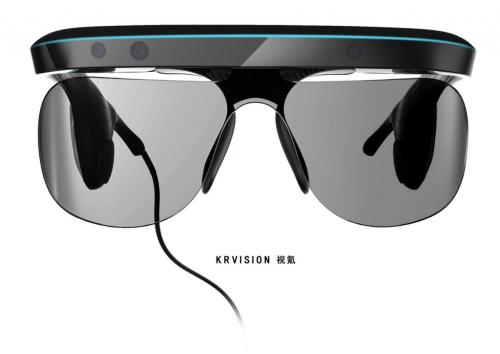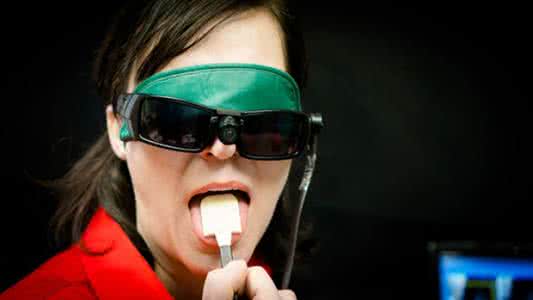

It is the best of times but also the worst of times for visually-challenged people like Xue Hong (pseudonym).
After living 50 years with a pair of beautiful eyes with perfect eyesight, she lost all sense of light in March due to a brain tumor. Had it happened years earlier, Xue would have to live with a cane, or if she can afford it, a guide dog. But now all she needs is a pair of special glasses.
In Hangzhou, a batch of special glasses is being prepared for its first delivery in late August.
The glasses, branded “Intoer,” from Hangzhou-based KR-Vision, can provide navigation support to blind people, including route and barrier detection, down to a few centimeters. With its help, blind people can avoid obstacles and walk up and down stairs.

(Photo/Courtesy of KR-Vision)
More than 200 of the first batch of 500 have been reserved. Later versions will add more functionality to help users “see” traffic lights, crossroads, cash, and even human faces or medical transcripts, according to Yu Honglei, CEO of KR-Vision.
“Our core technology is acoustic coding,” said Yu, founder of the company, which was born out of a laboratory at the College of Optical Science and Engineering at Zhejiang University. Associate Professor Wang Kaiwei from the university also serves as the chief scientist at KR-Vision, the only Chinese company focused on developing visual support glasses.
3D information of surroundings is collected and then converted into different sounds. Currently, the glasses use the sounds of seven musical instruments to mark out the environment. The company also provides an app called “Ting You,” or “Hearing Pal,” which allows users to customize their sounds to better “see” their environment.
Likewise, a US company is producing glasses based on a similar method, one which stimulates the tongue as a way to assist visually challenged people.
Located in the state of Wisconsin, the US medical device company Wicab has been boasting its BrainPort V100 Vision Aid since 2009. It first made a name for itself in China in 2015, when a young boy from Shanxi province who had lost his eyes was trained to see with the help of the device.

(File photo of a woman using Brainport V100 Vision Aid)
In 2016, the company set up operation in China. The company is currently collaborating with the China Disabled Persons’ Federation (CFDA) to help blind people train with the BrainPort device. It intends to apply for CFDA approval and start manufacturing the device in China, Kenny Min Zhou, general manager of Wicab China, told People’s Daily Online.
BrainPort was cleared for distribution in the U.S. by the Food and Drug Administration in June 2015 and is commercially available in the U.S., E.U., and Hong Kong.
The company’s founder, Professor Paul Bach-y-Rita, believed “you don't see with your eyes, you see with your brain,”said Zhou. According to the theory of neuroplasticity, the visual cortex is able to process the visual information by using sensory substitution.
Globally, more than 450 blind people have used BrainPort. Within an hour, most people can point to different shapes. After a few more hours, they can usually identify familiar objects and avoid obstacles, according to Zhou.
Wicab is also working with the Beijing Blind School to demonstrate the technology. Several children using BrainPort are now able to navigate the neighborhood, run on the track, and even throw darts. Though they remain unable to read books due to the limited acuity – it only has a resolution of 20x20 pixels, some can read simple Chinese characters in large print, Zhou revealed.
“We expect future product development to include sensory technologies to provide users with additional information while making our products more efficient and affordable,” he noted.
“Technologies such as retinal implants, or ‘bionic eyes,’ are limited to patients with retinitis pigmentosa and require special surgery. Our product provides similar if not better results and spares the eye in the event that a cure is later found. Also, the cost for our product is 1/15th that of a retinal implant, allowing us to serve more individuals,” Zhou said.
A BrainPort device is priced at around 30,000 yuan – a good price for many patients. But compared to the Chinese device, it does not stand a chance, as “Intoer” is only priced at around 5,000 yuan.
“We are similar to the U.S.-based Wicab, but our hardware is simpler and the core of our technology is the software. A user who has tried both products gave ours a thumb up for better interaction with the brain,” Yu told People’s Daily Online, adding that the “Hearing Pal” app also created a unique community for visually-challenged people, allowing them to better adapt to the product and express their support and encouragement.
“Blind people need more than an assistive device in life. They must first be confident that they can do it, in addition to the professional training offered by us and by authorities as well. Then they will be gradually able to leave their house and meet the outside world,” Yu said.
He added that the company also hopes to work with CDPF to add “Intoer” training to assistive programs.
“It is delightful to see more and more companies across the world focus on solutions for visually-challenged people, because different people can come up with different approaches. The advancement of technology now grants easier access to solutions with open source software. China can especially stand out here, as we hold dear to the ‘Internet way, of thinking’ which puts user experience at the core. We have been talking with different users during our trial phase so that we know how they really feel and what they really need,” Yu said.
 Fire brigade in Shanghai holds group wedding
Fire brigade in Shanghai holds group wedding Tourists enjoy ice sculptures in Datan Town, north China
Tourists enjoy ice sculptures in Datan Town, north China Sunset scenery of Dayan Pagoda in Xi'an
Sunset scenery of Dayan Pagoda in Xi'an Tourists have fun at scenic spot in Nanlong Town, NW China
Tourists have fun at scenic spot in Nanlong Town, NW China Harbin attracts tourists by making best use of ice in winter
Harbin attracts tourists by making best use of ice in winter In pics: FIS Alpine Ski Women's World Cup Slalom
In pics: FIS Alpine Ski Women's World Cup Slalom Black-necked cranes rest at reservoir in Lhunzhub County, Lhasa
Black-necked cranes rest at reservoir in Lhunzhub County, Lhasa China's FAST telescope will be available to foreign scientists in April
China's FAST telescope will be available to foreign scientists in April "She power" plays indispensable role in poverty alleviation
"She power" plays indispensable role in poverty alleviation Top 10 world news events of People's Daily in 2020
Top 10 world news events of People's Daily in 2020 Top 10 China news events of People's Daily in 2020
Top 10 China news events of People's Daily in 2020 Top 10 media buzzwords of 2020
Top 10 media buzzwords of 2020 Year-ender:10 major tourism stories of 2020
Year-ender:10 major tourism stories of 2020 No interference in Venezuelan issues
No interference in Venezuelan issues
 Biz prepares for trade spat
Biz prepares for trade spat
 Broadcasting Continent
Broadcasting Continent Australia wins Chinese CEOs as US loses
Australia wins Chinese CEOs as US loses